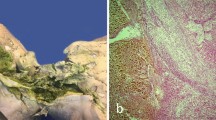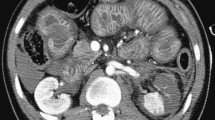Abstract
Introduction
Battle’s sign is a classical clinical sign that has long been held to be synonymous with fracture of the basal skull. As such the presence of Battle’s sign is a strong indicator that a basal skull fracture could be present in the head injured patient, as exemplified by its inclusion as a major risk factor in scoring systems designed to assess the likelihood of basal skull fracture.
Discussion
We present a case that describes the occurrence of this classic clinical sign in an unlikely setting and, for the first time since it was described more than 120 years ago, re-examine the pathologic basis for its appearance.

Similar content being viewed by others
References
Battle WH. Three lectures on some points relating to injuries to the head. British Medical Journal. 1890;I:57–63.
Stiell IG, Wells GA, Vandemheen K, et al. The Canadian CT head rule for patients with minor head injury. Lancet. 2001;357:1391–6.
Ferenci P, Lockwood A, Mullen K, et al. Hepatic encephalopathy—definition, nomenclature, diagnosis, and quantification: final report of the working party at the 11th World Congresses of Gastroenterology Vienna, 1998. Hepatology. 2002;35:716–21.
Pretto Flores L, De Almeida CS, Casulari LA. Positive predictive values of selected clinical signs associated with skull base fractures. J Neurosurg Sci. 2000;44:77–82.
Ibanez J, Arikan F, Pedraza S, et al. Reliability of clinical guidelines in the detection of patients at risk following mild head injury: results of a prospective study. J Neurosurg. 2004;100:825–34.
Herbella FA, Mudo M, Delmonti C, et al. Raccoon Eyes’ (periorbital haematoma) as a sign of skull base fracture. Injury. 2001;32:745–7.
Goh KY, Ahuja A, Walkden SB, Poon WS. Is routine computer tomographic (CT) scanning necessary in suspected basal skull fractures? Injury. 1997;28:353–7.
Detry O, De Roover A, Honore P, Meurisse M. Brain edema and intracranial hypertension in fulminant hepatic failure: pathophysiology and management. World J Gastroenterol. 2006;12:7405–12.
Valdueza JM, von Munster T, Hoffman O, Schreiber S, Einhaupl KM. Postural dependency of the cerebral venous outflow. Lancet. 2000;355:200–1.
Piechnik SK, Czosnyka M, Richards HK, Whitfield PC, Pickard JD. Cerebral venous blood outflow: a theoretical model based on laboratory simulation. Neurosurgery. 2001;49(5):1214–22.
Munoz SJ, Robinson M, Northrup B, Bell R, Moritz M, Jarrell B, et al. Elevated intracranial pressure and computed tomography of the brain in fulminant hepatocellular failure. Hepatology. 1991;13:209–12.
Author information
Authors and Affiliations
Corresponding author
Additional information
Supported solely by departmental funds.
Rights and permissions
About this article
Cite this article
Ackland, G.L., O’Beirne, J., Platts, A.R. et al. False-Positive Presentation of Battle’s Sign During Hepatic Encephalopathy. Neurocrit Care 9, 253–255 (2008). https://doi.org/10.1007/s12028-008-9116-5
Published:
Issue Date:
DOI: https://doi.org/10.1007/s12028-008-9116-5




